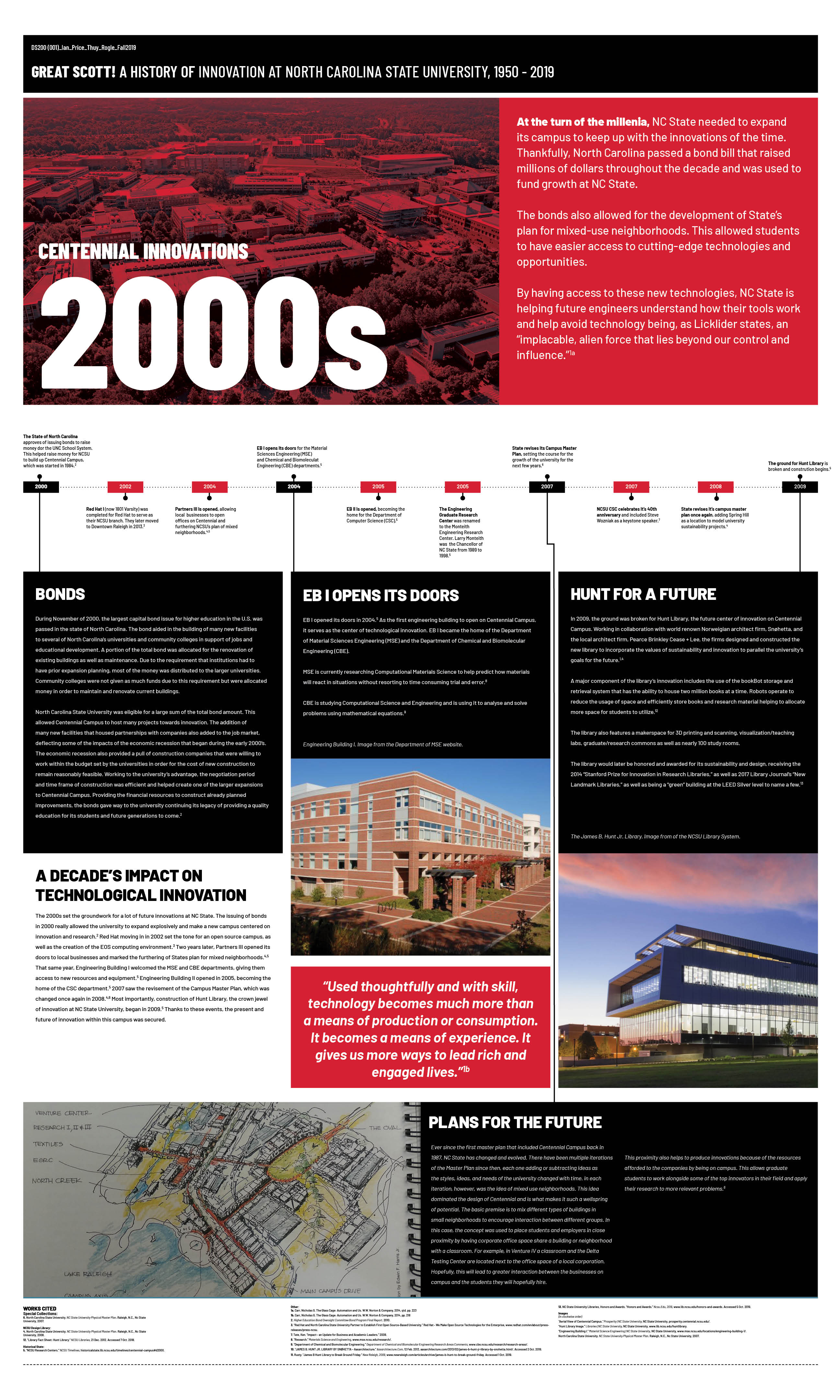Centennial Innovations | 2000s
At the turn of the millennia, NC State needed to expand its campus to keep up with the innovations of the time. Thankfully, North Carolina passed a bond bill that raised millions of dollars throughout the decade and was used to fund growth at NC State.
The bonds also allowed for the development of State’s plan for mixed-use neighborhoods. This allowed students to have easier access to cutting-edge technologies and opportunities.
By having access to these new technologies, NC State is helping future engineers understand how their tools work and help avoid technology being, as Licklider states, an “implacable, alien force that lies beyond our control and influence.”1a
“Used thoughtfully and with skill, technology becomes much more than a means of production or consumption. It becomes a means of experience. It gives us more ways to lead rich and engaged lives.”1b
| Timeline | |
|---|---|
| 2000 | The State of North Carolina approves of issuing bonds to raise money dor the UNC School System. This helped raise money for NCSU to build up Centennial Campus, which was started in 1984.2 |
| 2002 | Red Hat I (now 1801 Varsity) was completed for Red Hat to serve as their NCSU Branch. They later moved to Downtown Raleigh in 2013.3 |
| 2004 | Partners III is opened, allowing local businesses to open offices on Centennial and furthering NCSU’s plan of mixed neighborhoods.4,5 |
| 2004 | EB I opens its doors for the Material Sciences Engineering (MSE) and Chemical and Biomolecular Engineering (CBE) departments.5 |
BONDS
During November of 2000, the largest capital bond issue for higher education in the U.S. was passed in the state of North Carolina. The bond aided in the building of many new facilities to several of North Carolina’s universities and community colleges in support of jobs and educational development. A portion of the total bond was allocated for the renovation of existing buildings as well as maintenance. Due to the requirement that institutions had to have prior expansion planning, most of the money was distributed to the larger universities. Community colleges were not given as much funds due to this requirement but were allocated money in order to maintain and renovate current buildings.
North Carolina State University was eligible for a large sum of the total bond amount. This allowed Centennial Campus to host many projects towards innovation. The addition of many new facilities that housed partnerships with companies also added to the job market, deflecting some of the impacts of the economic recession that began during the early 2000’s. The economic recession also provided a pull of construction companies that were willing to work within the budget set by the universities in order for the cost of new construction to remain reasonably feasible. Working to the university’s advantage, the negotiation period and time frame of construction was efficient and helped create one of the larger expansions to Centennial Campus. Providing the financial resources to construct already planned improvements, the bonds gave way to the university continuing its legacy of providing a quality education for its students and future generations to come.2
EB I OPENS ITS DOORS
EB I opened its doors in 2004.5 As the first engineering building to open on Centennial Campus, it serves as the center of technological innovation. EB I became the home of the Department of Material Sciences Engineering (MSE) and the Department of Chemical and Biomolecular Engineering (CBE).
MSE is currently researching Computational Materials Science to help predict how materials will react in situations without resorting to time consuming trial and error.8
CBE is studying Computational Science and Engineering and is using it to analyze and solve problems using mathematical equations.9

Comments by iwprice